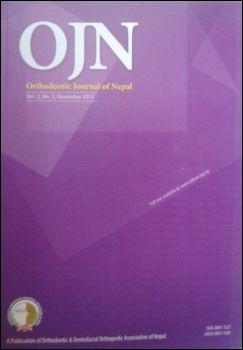Effect of Orthodontic Treatment in Occurrence of Dental Caries
DOI:
https://doi.org/10.3126/ojn.v3i1.9279Keywords:
dental caries, DMFT, malocclusion, occurrence, orthodontic treatment, prevalenceAbstract
Introduction: Attaining improved aesthetics and proper occlusion are main reasons for commencing orthodontic treatment in any patient. However it is anticipated that orthodontic treatment increases the risk of carious lesions.
Objective: To analyze prevalence of dental caries in relation to gender, age group, duration of orthodontic treatment and malocclusion type; and to assess oral hygiene and food habit practice in Nepalese orthodontic patients.
Materials & Method: A cross sectional study was done in 212 orthodontic patients (age range 11-30 years) having fixed appliance for at least six months duration. A survey form based on ‘Dentition Status & Treatment Need, WHO’ was used to depict DMFT Index and prevalence of dental caries. A questionnaire was used to assess the practice of oral hygiene measures and food habits of the orthodontic patients. The association between dental caries and gender, age group, duration of orthodontic treatment and malocclusion type were analyzed using chi-square test (p<0.05).
Result: The prevalence of dental caries (DMFT) was 79.2% and mean DMFT value was 2.87 among Nepalese orthodontic patients. Occurrence of dental caries among male and female patients was 69.44% and 60% respectively. Caries occurrence was highest in age group 16-20 years (72.22%), in more than 18 months treatment duration group (63.92%) and in Class I malocclusion group (68.38%). Similarly, 30.2% consume sweets foodstuff, 26.9% consume junk food and 14.2% consume snacks in between meals frequently.
Conclusion: Fairly good proportion of Nepalese orthodontic patients practice normal oral hygiene methods but very few use special oral hygiene measures. The study showed no association between dental caries occurrence and gender groups, age groups, duration of orthodontic treatment and malocclusion types.
DOI: http://dx.doi.org/10.3126/ojn.v3i1.9279
Orthodontic Journal of Nepal, Vol.3, No.1, 2013: 31-36
Downloads
Downloads
Published
How to Cite
Issue
Section
License
Copyright © held by Orthodontic & Dentofacial Orthopedic Association of Nepal
- Copyright on any research article is transferred in full to the Orthodontic & Dentofacial Orthopedic Association of Nepal upon publication in the journal. The copyright transfer includes the right to reproduce and distribute the article in any form of reproduction (printing, electronic media or any other form).
- Articles in the Orthodontic Journal of Nepal are Open Access articles published under the Creative Commons CC BY License (https://creativecommons.org/licenses/by/4.0/)
- This license permits use, distribution and reproduction in any medium, provided the original work is properly cited.




